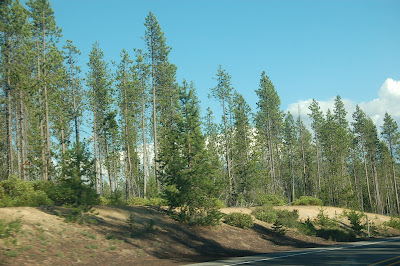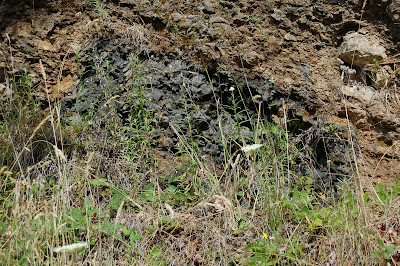This is the final portion of the spoken presentation that I gave about three weeks ago for the Oregon Master Naturalist Program at Silver Falls State Park, east of Salem, Oregon. There was another planned portion, on non-tectonic geologic hazards- I had intended to focus mainly on mass movement, with some mentions of flooding, though I don't have any good photos or images of the latter. However, due to some issues with logistics, time became an issue, and we dropped that segment. I will cover it in much the same way as with this and the previous four segments. I should also do a quick and dirty summary of Bob Lillie's portion, on plate tectonics and the tectonic setting of the Willamette Valley. In addition, I had about 30 rock samples to illustrate typical kinds of geologic material one might find in and around our area. I don't have photos, yet, but I may get up the gumption to take some shots, and I've kept the sheets I placed the samples upon, with names and notes for each, so it shouldn't be too much trouble to transcribe those.
We had anticipated walking down the path to North Falls, which definitely has the most diverse and interesting geology in the park, but the smallish parking area there was almost completely full. While we had anticipated problems with everyone driving, and had arranged ahead of time for participants to pool into a minimum number of cars, we still had about 7 vehicles, and when we arrived, there was one parking spot available. So we regrouped at a nearby parking area with an overlook, and decided to bag North Falls. Parking at South Falls is much more extensive, so we headed there. We had planned on visiting the CCC building, with its marvelous fossils anyway, and while the geology exposed at South Falls isn't as in-your-face, we figured it would suffice... and it turned out better than we'd planned, for reasons I'll get to presently.
I'm also going to submit this as my entry for this month's
Accretionary Wedge, hosted by
Evelyn of Georneys,
Fun Field Camp/Trip Moments, because this did indeed end up being a lot of fun.
Bob Lille and his wife, on the scouting trip a couple weeks before our presentation, approaching North Falls. Silver Falls isn't exactly unique, but perhaps a bit unusual, in that there are a number of falls you can see from underneath and behind. The trails "cross' their respective streams not by going over, but under.
One thing I've particularly noticed about these photos is how difficult it is to appreciate the scale here; this alcove is simply
huge! In the photo above, note the dark horizontal band of sediment...
...and again here, with some people for scale. The rock layers aren't terribly distinct, but the underlying resistant layer is Columbia River Basalt (CRB) of the Grande Ronde series, as is the upper shelf-forming layer. In between is a layer of stream-carried sediment. I had been under the impression this was marine- from when the Willamette Valley was a shallow embayment- but other sources say this was terrestrial, and that actually fits better with what you can see first hand.
Another shot showing the sheer scale of this overhang.
Light scratches are graffitti, dark lines are cross bedding in the sedimentary layer. The sediment, particularly the upper portions, have been somewhat cooked and hardened by contact metamorphism.
Looking up at the overlying basalt, there are numerous tree casts; we're standing in the root zone, looking up into where a pair of trees were swamped by a flood of basalt. Had this been a marine environment, there wouldn't have been trees growing here.
Looking out toward North Falls and down the gorge.
Almost out on the other side of the alcove.
And looking back at where we've been. The height of this waterfall is 136 feet, 23 times my height of 70 inches.
On our scouting trip, we walked the loop from North Falls, down stream to Winter Falls- so called because it merely drips during dry months- climbed out of the canyon there, then followed the rim trail back to the North Falls parking area.
Durning Dana's visit in March, the North Falls trail was closed due to snow and ice, so we spent more of our time at South Falls. For the OMN workshop, I told the participants that the sediment layer was clear at North Falls, but I hadn't looked carefully enough here to be certain whether there was a similar weak sediment layer responsible for the shelf, or if it was maybe a paleosol instead. Bob suggested that they look carefully to see if they could find evidence for one or the other. Sediment ought to be clearly layered, while a palesol ought to be more massive- perhaps with evidence of preserved roots. But the upshot is that we were quite up front and honest about what we didn't know, and gave the learners a chance to figure it out for themselves.

As you can see from the previous two pictures, much of the exposure is covered with lichen and moss, so finding clues consists in large part of gently pushing aside enough of the botany to see the weathered, crumbly geology underneath. But the students were successful, and we managed to find several spots where the weak horizon showed clear sedimentary layering. So the interflow sedimentation here is not as pronounced as at North Falls, but it clearly is a sedimentary interval, not just a weathering interval.
I also wanted to show the participants some of the other scenes in the park that we wouldn't have time to visit during the workshop, so above is Lower South Falls, a bit more than a mile below Upper South Falls, from the visit with Dana in March. Flow rates were much, much lower in mid-September.
And this is Upper North Falls, about a half mile upstream from the North Falls parking area.
North Falls from the rim overlook in March. The wind wasn't too stiff, but from the cloud condensation, you should be able to infer it was from the left (west), moving to the right. I'll get back to this in a bit...
I think this may be from the chimney on the backside of the gift shop at South Falls, the other building at Silver Falls that used this fossiliferous siltstone/sandstone from the rock quarried by the CCC (Civilian Conservation Corps) in the 1930s
But the fossils are more abundant and more diverse in the CCC building itself- the above looks like a nice assemblage of filter feeders: clams and razor clams.
A view of the building.
Fossils with lens cap, 52 mm diameter, for scale.
And another, zoomed in on the same spot. There are four major distinct rock groups in the park; the lowermost is this fossiliferous sediment. Next oldest is CRB flows of the Grande Ronde group, and interbedded with those is the stream sediment so nicely exposed at North Falls, and above that are some tuffs from Cascades volcanism. We found that examples of the three other than the interbedded stream sediment are used either in or very close to the CCC building, making that location a very good spot to summarize the overall geologic history of the area.
A block of the tuff, used as a landscaping stone, near the South Falls parking area.

I concluded this portion of the workshop by mentioning that even if you know nothing about the rocks, even if you know nothing about what types are around, or what processes formed them and put them where they are, the simple fact of two enormous piles of them in parallel north-south ridges have a profound effect on us here in western Oregon. The town where I live gets about 42 inches of rain on average per year. If I traveled up to the Coast Range Crest, that number can get as high as 160 to 200 inches per year. Maximum annual rainfall in the Cascades doesn't get quite as high, but can still go over 150 inches per year. Those extreme differences are due to rapid elevation changes- that is, rocks. These variations in rainfall create huge differences in vegetation. Even after more than 30 years in this area, I still find myself gasping at our rich, luxurious vegetation, especially at the epiphytes, as shown by the moss growing on the maple above.

And all animal life ultimately depends on the plants they live upon and around, which in turn depend on rocks for nutrients and as a substrate. Geology is a sadly ignored discipline, often treated as a remedial subject for those too "dumb" to "get" "real" science, or, at the other end of the absurd preconceptions spectrum, as hopelessly nitpicky: "Why so many different names and terms? I mean they're just rocks! How much detail can there be?"
But the fact is, if you love forests and plants and wildlife, you can thank the rocks that underpin it all.






































































